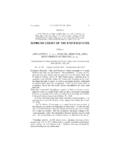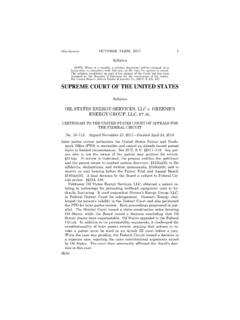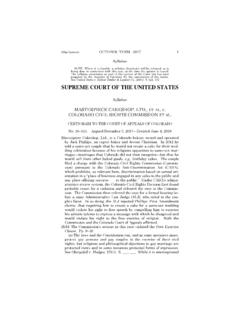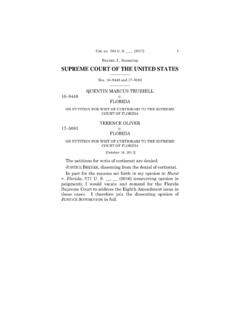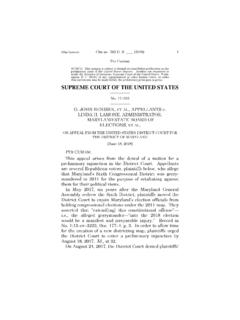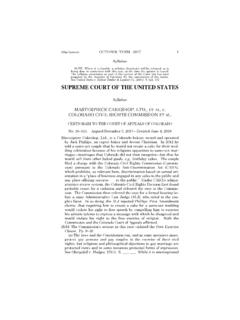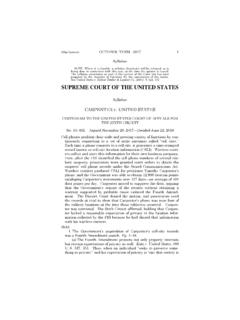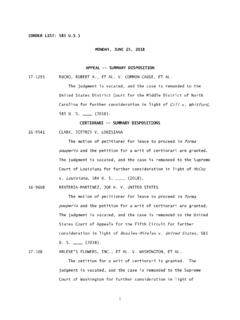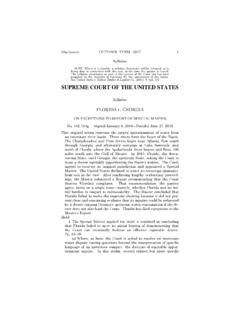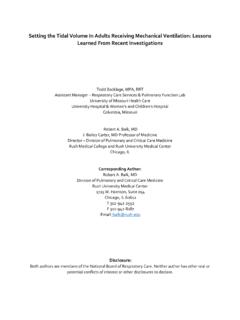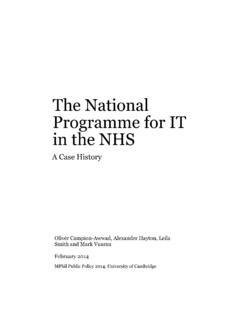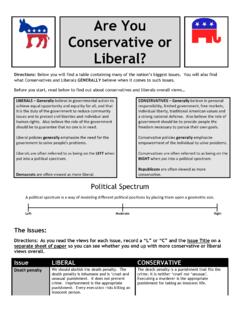Transcription of SUPREME COURT OF THE UNITED STATES
1 _____ _____ 1 (Slip Opinion) Cite as: 595 U. S. ____ (2022) Per Curiam NOTICE: This opinion is subject to formal revision before publication in the preliminary print of the UNITED STATES Reports. Readers are requested to notify the Reporter of Decisions, SUPREME COURT of the UNITED STATES , Wash-ington, D. C. 20543, of any typographical or other formal errors, in order that corrections may be made before the preliminary print goes to press. SUPREME COURT OF THE UNITED STATES Nos. 21A244 and 21A247 NATIONAL FEDERATION OF INDEPENDENT BUSINESS, ET AL., APPLICANTS 21A244 v. DEPARTMENT OF LABOR, OCCUPATIONAL SAFETY AND HEALTH ADMINISTRATION, ET AL. OHIO, ET AL., APPLICANTS 21A247 v. DEPARTMENT OF LABOR, OCCUPATIONAL SAFETY AND HEALTH ADMINISTRATION, ET AL.
2 ON APPLICATIONS FOR STAYS [January 13, 2022] PER CURIAM. The Secretary of Labor, acting through the Occupational Safety and Health Administration, recently enacted a vac-cine mandate for much of the Nation s work force. The mandate, which employers must enforce, applies to roughly84 million workers, covering virtually all employers with at least 100 employees. It requires that covered workers re-ceive a COVID 19 vaccine, and it pre-empts contrary state laws. The only exception is for workers who obtain a medi-cal test each week at their own expense and on their own time, and also wear a mask each workday. OSHA has never before imposed such a mandate. Nor has Congress. Indeed, although Congress has enacted significant legislation ad-dressing the COVID 19 pandemic, it has declined to enact 2 NATIONAL FEDERATION OF INDEPENDENT BUSINESS v.
3 OSHA Per Curiam any measure similar to what OSHA has promulgated here. Many STATES , businesses, and nonprofit organizationschallenged OSHA s rule in Courts of Appeals across the country. The Fifth Circuit initially entered a stay. But when the cases were consolidated before the Sixth Circuit, that COURT lifted the stay and allowed OSHA s rule to takeeffect. Applicants now seek emergency relief from thisCourt, arguing that OSHA s mandate exceeds its statutory authority and is otherwise unlawful. Agreeing that appli-cants are likely to prevail, we grant their applications and stay the rule. I A Congress enacted the Occupational Safety and HealthAct in 1970.
4 84 Stat. 1590, 29 U. S. C. 651 et seq. The Act created the Occupational Safety and Health Administra-tion (OSHA), which is part of the Department of Labor and under the supervision of its Secretary. As its name sug-gests, OSHA is tasked with ensuring occupational safety that is, safe and healthful working conditions. 651(b). It does so by enforcing occupational safety and health stand-ards promulgated by the Secretary. 655(b). Such stand-ards must be reasonably necessary or appropriate to pro-vide safe or healthful employment. 652(8) (emphasisadded). They must also be developed using a rigorous pro-cess that includes notice, comment, and an opportunity fora public hearing. 655(b).The Act contains an exception to those ordinary notice-and-comment procedures for emergency temporary stand-ards.
5 655(c)(1). Such standards may take immediate ef-fect upon publication in the Federal Register. Ibid. Theyare permissible, however, only in the narrowest of circum-stances: the Secretary must show (1) that employees are exposed to grave danger from exposure to substances or agents determined to be toxic or physically harmful or from 3 Cite as: 595 U. S. ____ (2022) Per Curiam new hazards, and (2) that the emergency standard is nec-essary to protect employees from such danger. Ibid. Prior to the emergence of COVID 19, the Secretary had used thispower just nine times before (and never to issue a rule as broad as this one). Of those nine emergency rules, six werechallenged in COURT , and only one of those was upheld in BST Holdings, v.
6 Occupational Safety and Health Admin., 17 F. 4th 604, 609 (CA5 2021). B On September 9, 2021, President Biden announced anew plan to require more Americans to be vaccinated. Re-marks on the COVID 19 Response and National Vaccina-tion Efforts, 2021 Daily Comp. of Pres. Doc. 775, p. 2. As part of that plan, the President said that the Department of Labor would issue an emergency rule requiring all em-ployers with at least 100 employees to ensure their work-forces are fully vaccinated or show a negative test at least once a week. Ibid. The purpose of the rule was to increase vaccination rates at businesses all across America. Ibid. In tandem with other planned regulations, the administra-tion s goal was to impose vaccine requirements on about 100 million Americans, two-thirds of all workers.
7 Id., at 3. After a 2-month delay, the Secretary of Labor issued thepromised emergency standard. 86 Fed. Reg. 61402 (2021). Consistent with President Biden s announcement, the rule applies to all who work for employers with 100 or more em-ployees. There are narrow exemptions for employees who work remotely 100 percent of the time or who workexclusively outdoors, but those exemptions are largely il-lusory. Id., at 61460. The Secretary has estimated, for ex-ample, that only nine percent of landscapers and groundskeepers qualify as working exclusively outside. Id., at 61461. The regulation otherwise operates as a blunt in-strument. It draws no distinctions based on industry or risk of exposure to COVID 19.
8 Thus, most lifeguards and 4 NATIONAL FEDERATION OF INDEPENDENT BUSINESS v. OSHA Per Curiam linemen face the same regulations as do medics and meat-packers. OSHA estimates that million employees are subject to its mandate. Id., at 61467. Covered employers must develop, implement, and en-force a mandatory COVID 19 vaccination policy. Id., at 61402. The employer must verify the vaccination status of each employee and maintain proof of it. Id., at 61552. The mandate does contain an exception for employers that re-quire unvaccinated workers to undergo [weekly] COVID 19 testing and wear a face covering at work in lieu of vac-cination.
9 Id., at 61402. But employers are not required to offer this option, and the emergency regulation purports topre-empt state laws to the contrary. Id., at 61437. Unvac-cinated employees who do not comply with OSHA s rule must be removed from the workplace. Id., at 61532. And employers who commit violations face hefty fines: up to $13,653 for a standard violation, and up to $136,532 for a willful one. 29 CFR (d) (2021). C OSHA published its vaccine mandate on November 5, 2021. Scores of parties including STATES , businesses, trade groups, and nonprofit organizations filed petitions for review, with at least one petition arriving in each re-gional COURT of Appeals. The cases were consolidated in the Sixth Circuit, which was selected at random pursuant to 28U.
10 S. C. 2112(a).Prior to consolidation, however, the Fifth Circuit stayedOSHA s rule pending further judicial review. BST Hold-ings, 17 F. 4th 604. It held that the mandate likely ex-ceeded OSHA s statutory authority, raised separation-of-powers concerns in the absence of a clear delegation fromCongress, and was not properly tailored to the risks facingdifferent types of workers and the consolidated cases arrived at the Sixth Circuit, two things happened. First, many of the petitioners 5 Cite as: 595 U. S. ____ (2022) Per Curiam nearly 60 in all requested initial hearing en banc. Second, OSHA asked the COURT of Appeals to vacate the Fifth Cir-cuit s existing stay. The Sixth Circuit denied the requestfor initial hearing en banc by an evenly divided 8-to-8 vote.
